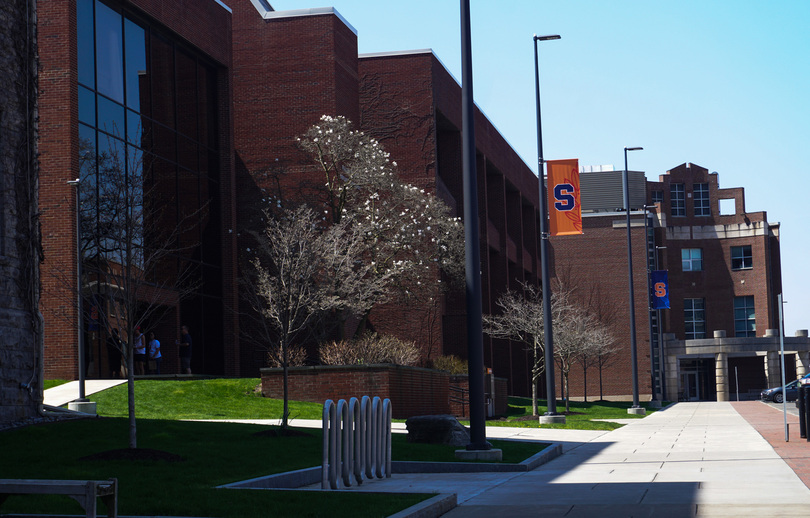Stronger steps need to be taken against swatting at SU

Leanne Rivera | Staff Photographer
In response to increases in swatting cases nationwide and on-campus, SU should outline clear policies detailing the punishment.
To support student journalism and the content you love, become a member of The Daily Orange today.
Nationwide, universities work to maintain a cohesive and safe campus. But a new rising phenomenon called swatting — the act of making a false report to have authorities show up in tactical gear — has resulted in unsafe and chaotic environments. Many universities have no regulations or punishments to combat this rising issue. Due to recent swatting incidents at Syracuse University, the administration and the university’s Department of Public Safety should outline clear policies and protocols to respond appropriately and maintain student safety.
SU received two false reports of shootings — at College Place and the Maxwell School of Citizenship and Public Affairs — within a week. In both cases, there was a steady fear around campus as students were unsure of the severity of the situation. In the hours before confirmation of the first false reports, students were frantically texting each other and warning their loved ones about the reported active shooter on campus.
In each case, DPS investigated the scene and discovered the claims were false. But what should happen next is the most pressing question. As of now, nothing has changed, or at least, students are once again left unaware.
Those who use swatting as a tool do so to get what they want: a reaction. According to Michael G. Masters, the national director of the Secure Community Network, swatting is usually “done to cause fear or to spark a law-enforcement response to waste resources.” People who perform acts of swatting have different reasons for their actions, from small things like causing gossip to extremes like schools being shut down. Since these false reports are intentional, swatters usually use a personal place, like their place of work, school or other significant location.
Many also overlook the dangers of swatting. In 2020, 60-year old Mark Hearing died from swatting. The motivation? Twitter. Shane Sonderman, one of the swatters, wanted Hearing’s Twitter handle, so Sonderman called the police to his house with a fake account. When enforcement arrived, Hearing was scared and anxious, and died from a heart attack. After his death, his daughter said the swatting was the cause: “I believe from the adrenaline and the guns in his face…a heart attack happened.” This devastating circumstance is one of many that can occur.
In today’s world, violent acts like school shootings have become a reality. When swatters make false claims, they undermine the importance of real active shooting reports. And it’s incredibly insensitive, especially after the recent Covenant School tragedy.
If DPS keeps letting false reports go without consequence, SU students may become desensitized to actual active shooter threats. In the case of a real shooting, some students may not choose to seek shelter, due to their past experiences with false threats. They may just think it’s another prank call from a swatter.
We should be following in the footsteps of New York state, which has tried to make efforts in not only keeping schools safe, but enforcing punishments for swatters. New York’s superintendent, Steven Nigrelli, has promised that this issue is a priority: “We proactively work with our agency partners on the School Safety Improvement Team as well as our local enforcement partners to support their efforts…Let me be clear, swatting incidents…which disrupt our schools and divert valuable state resources, will not be tolerated, and we are committed to finding those responsible.”
To further enforce his statement, the New York Police and the State Education Department sent out a letter to school administrators informing them how to remain prepared and what measures to take to remain safe at school. Legislators have also contributed to this new inquiry by proposing two bills: Assembly Bill A6383 establishes the threat of mass violence, and Senate Bill S4283 makes it a felony offense to falsely report an incident in the second degree. Ultimately, these bills establish sanctions on anyone who carries out a false report.
SU must notice the dangerous trends occuring in the state and educate itself on the legislation being proposed that prevent in the process. On April 11, DPS sent a statement explaining the damage of swatting, how it condemns it and why the Orange Alert system is so important. Sadly, talk is cheap with this statement when it affects people’s lives. DPS did not discuss the essential topic: protocols and punishments moving forward. Although DPS knows that swatting affects the community, it has taken little to no action in creating well-deserved penalties for those sending this campus into a state of fear and anxiety.
Having an alert system, like Orange Alert, is vital to keep a safe campus. However, there needs to be a way to distinguish between actual threats and pranks, especially if DPS refuses to use the alert system because “the service is reserved for imminent threats of physical danger, and not for rumors.”
After identifying anyone who makes a false claim, there needs to be further investigations. DPS needs to evaluate why a person would make such a claim, whether they actually think there was a potential threat or if they just wanted to start a panic. With this, SU can evaluate the level of punishment the perpetrator may receive. A fine, a temporary suspension, community service or even expulsion should be considered as responses to cases of swatting, and these policies should be clearly communicated to the student body so it knows DPS is working to improve the situation.
As for students, we need to understand the severity of such pranks. Widespread collateral damage ensues when false accusations are made. Not only can this frighten students at SU, but it could lead to a possible death. And no student’s life is worth a prank call.
Sophia Leone is a sophomore broadcast, digital journalism and political science major. Her column appears biweekly. She can be reached at seleone@g.syr.edu.





